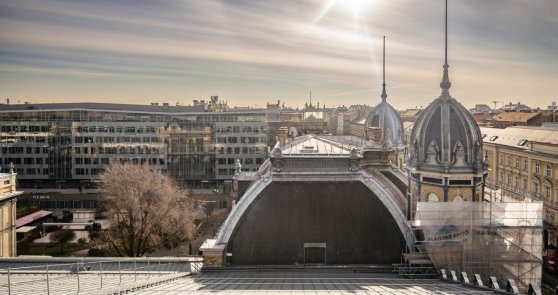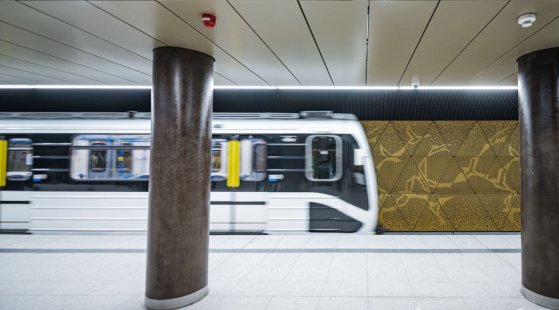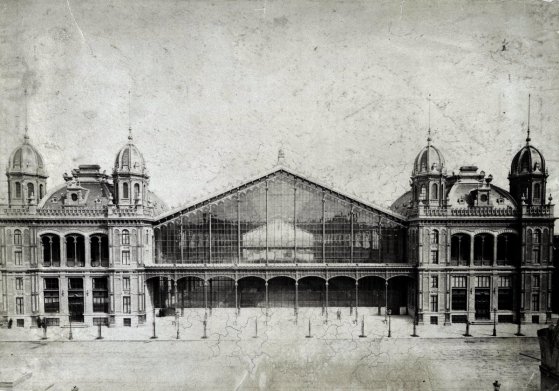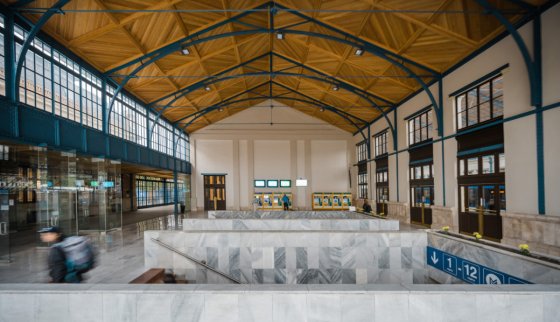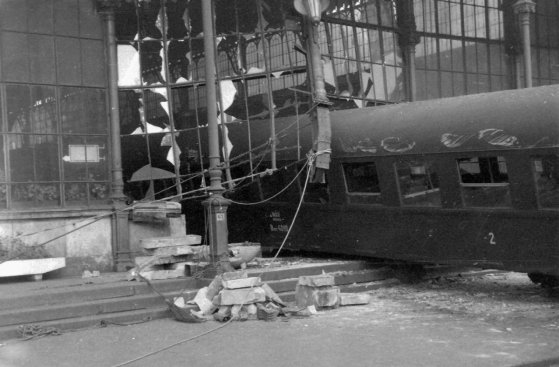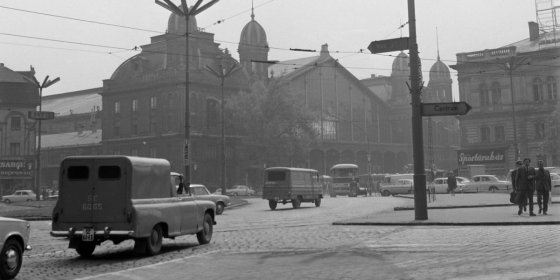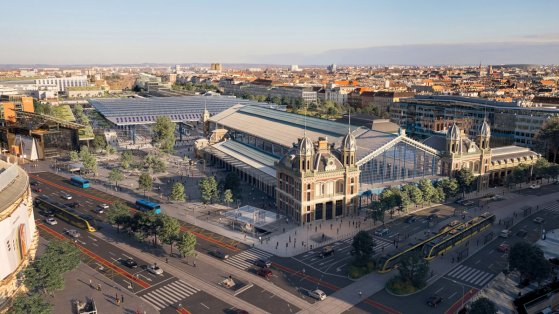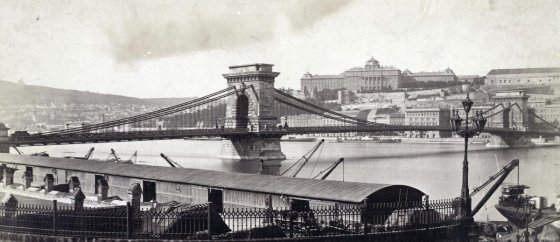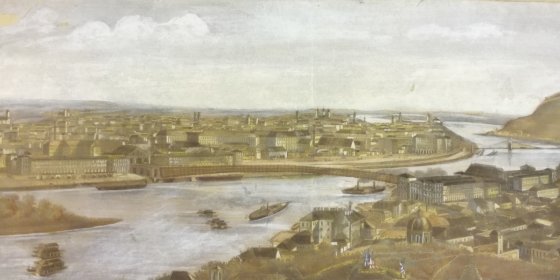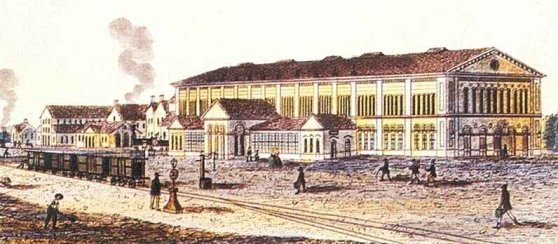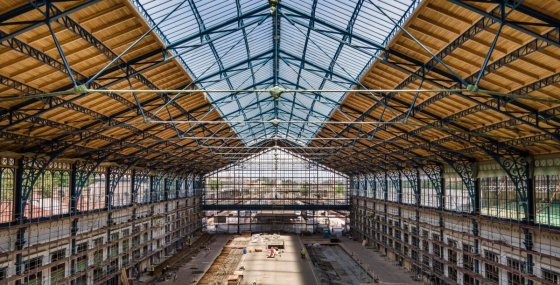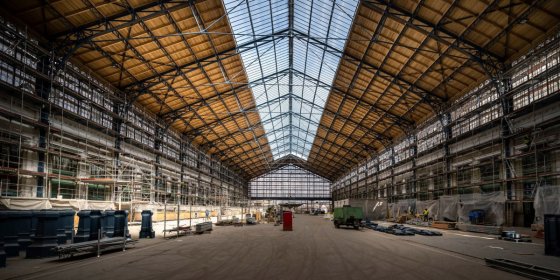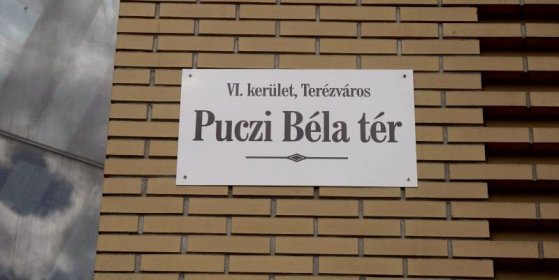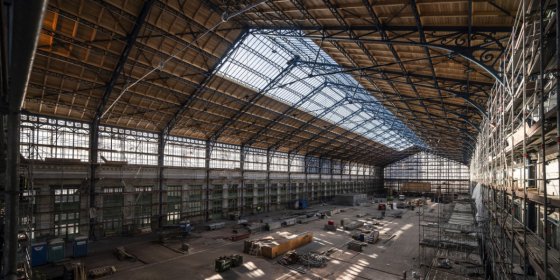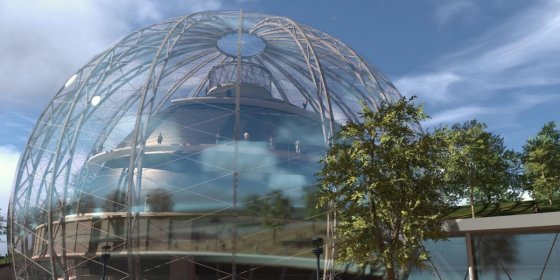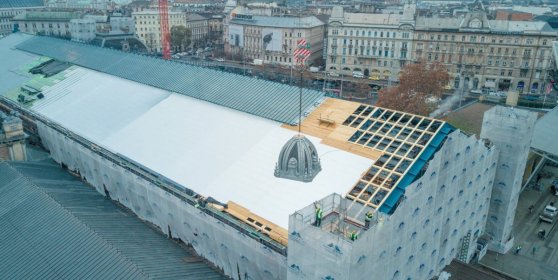 The „intertwined history” of the bridges and the city of Budapest
Which ideas and events have shaped the fate of bridges of Budapest and the cityscape? Alongside many other interesting facts, this question is also answered this newly published book by the Budapest City Archives, which introduces the history of bridges in Budapest.
The „intertwined history” of the bridges and the city of Budapest
Which ideas and events have shaped the fate of bridges of Budapest and the cityscape? Alongside many other interesting facts, this question is also answered this newly published book by the Budapest City Archives, which introduces the history of bridges in Budapest.
Nyugati Railway Station
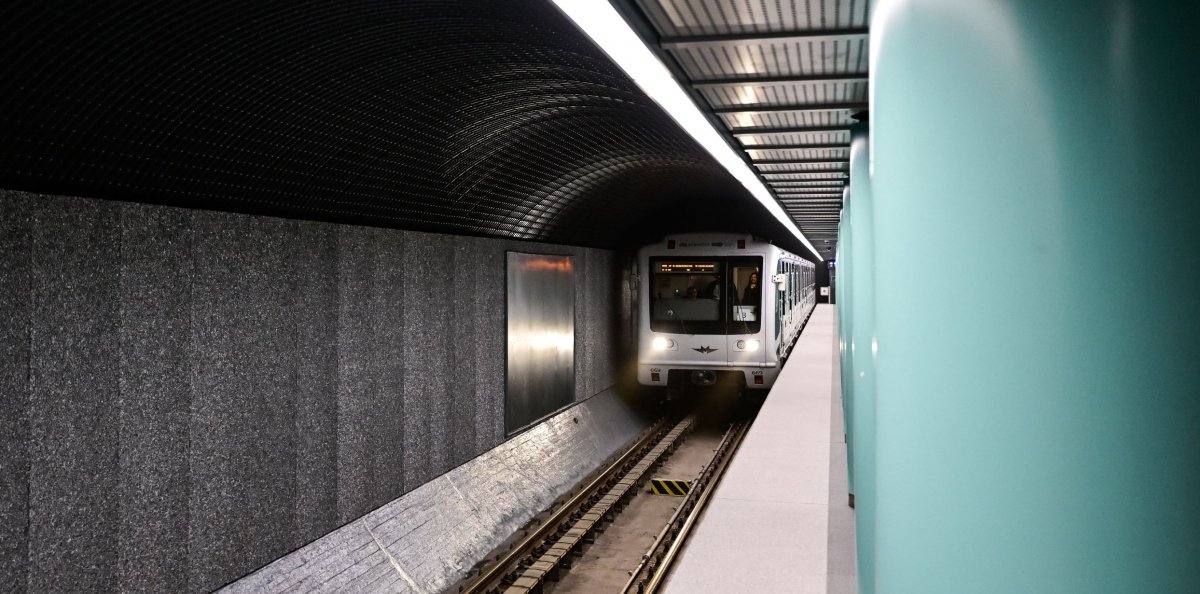 The Arany János Street and Nyugati Railway Station metro stations were handed over
The Arany János Street and Nyugati Railway Station metro stations were handed over
March 20, 2023 at 3:00 PM
Metro line M3 runs again on the entire line, between Kőbánya-Kispest and Újpest Centre, but trains do not stop at Nagyvárad Square and Lehel Square. On 20 March, the renovated Arany János Street and Nyugati Railway Station metro stations were opened to passenger traffic, and access to the Dózsa György Road station became barrier-free.
Trains will be running again from 20 March on the entire M3 line on weekdays
March 10, 2023 at 3:00 PM
Trains will be running again from 20 March on the entire M3 line, between Újpest Centre and Kőbánya-Kispest, but it is still not stopping at Lehel Square and Nagyvárad Square stations. The renovation of metro line 3 is expected to be completed in May.
The renovation of Nyugati Railway Station continues with spectacular developments
February 6, 2023 at 7:00 PM
In addition to the renovation of the north-west tower on the Teréz Boulevard facade of the Nyugati Railway Station, work will also begin on the south-east tower. The protective roof in front of the renewed facade is expected to be demolished in autumn.
The renewed Deák Ferenc Square and Ferenciek Square stations on metro line 3 were handed over
January 23, 2023 at 3:00 PM
In the early afternoon of 23 January, Ferenciek Square and Deák Ferenc Square stations on metro line 3 were opened to passenger traffic, after which it is possible to travel between Kőbánya-Kispest and Deák Ferenc Square. The complete reconstruction of the line is scheduled to be completed in May 2023.
The railway station that was cut in two
October 29, 2022 at 11:00 AM
By the beginning of the 1870s, the first railway station in Pest - the predecessor of Nyugati (Western), then known as Pest Station Building - was no longer able to handle the ever-increasing railway traffic smoothly. The owner railway company started the expansion, but then it turned out that the building stood in the way of the planned Outer Ring Road. Therefore, the old hall was "halved" and a new railway station was built over its northern part. The Nyugati Railway Station, as it is known today, was handed over on 28 October 1877, i.e., 145 years ago.
The Marble Hall in Nyugati was handed over, a significant part of the roof was completed
October 28, 2022 at 8:30 PM
The renovation of the roof structure of the 145-year-old Nyugati (Western) Railway Station began in the spring of 2020 and the reconstruction of important parts of the building complex has now been completed. The roof is completed over the Marble Hall, the international waiting room, the former ABC, the Cegléd Corridor and the office wing facing Nyugati Square. In addition, passengers can now use the renovated Marble Hall and the Cegléd Corridor.
A railway carriage got out of control and ended up on the Outer Ring Road
October 4, 2022 at 10:30 AM
Sixty years ago, on 4 October 1962, a railway carriage tore through the buffer stop of the main hall of the Nyugati (Western) Railway Station, breaking through the glass wall and running onto the Outer Ring Road. The accident was caused by human error, but thanks to the presence of mind of a railwayman, there was no mass catastrophe.
Bridge over Marx Square - Fifty years ago, the environment of the Nyugati Railway Station was imagined this way
July 8, 2022 at 11:00 AM
The design competition for the arrangement of the area around the Nyugati railway station was closed a few months ago. In the new ideas, a more livable, greener railway station environment and Nyugati Square were outlined, and the road overpass crossing the square was no longer considered. Fifty years ago, however, the future of the railway station was imagined quite differently. The results of the design competition at the time were announced in the press on 8 July 1972.
The development of Nyugati railway station won EU funds
June 29, 2022 at 4:00 PM
The National Transportation Center won 2.8 million euros, i.e. 1.1 billion HUF, in EU funds for planning the development of the Nyugati railway station. The development of the Southern Ring Road in the capital also received an excellent rating in the EU tender.
Before the big changes - Budapest at the time of the compromise
May 2, 2022 at 11:00 AM
The Austro-Hungarian Compromise, established in 1867, ushered in one of Hungary's heyday. Under the Compromise of 155 years ago, a dual system was created - hence our common word dualism, which is used to characterise the period up to 1918. This upswing has brought about great changes: as a result of industrialisation, more and more people have moved to the cities, and the population of Budapest has grown exponentially. But what was the capital like in the second half of the 1860s?
The connection between Nyugati and Déli Railway Stations was also planned in the 19th century - now it is made underground
February 22, 2022 at 9:00 AM
In recent years, the idea has emerged to connect the Déli and Nyugati Railway Stations with a tunnel. The plan of the Budapest Development Centre is now one step closer to implementation, as a contract has been signed for the preparation of an environmental impact assessment of the connecting railway tunnel to be built under the Danube. The idea of connecting the Déli [Southern] and Nyugati [Western] Railway Stations, which are relatively close to each other, is not a new idea. It arose almost immediately after the opening of the Déli Railway Station in 1861, although an overground connection was still imagined at the time.
A train pulled out of Budapest's first railway station 175 years ago
July 15, 2021 at 9:00 AM
The first station building ('indóház') in Pest was handed over on 15 July 1846, from where the first Hungarian steam-powered train to Vác, which was the first section of the railway line to Vienna, left. With rail transport, the central role of Pest has been strengthened within the country and it set a significant development in motion. So much so that by the 1870s, rail traffic had outgrown Pest's first railway station.
Nyugati Railway Station closed for a month
June 8, 2021 at 6:00 PM
The renovation of the Western Railway Station, which started last year, has entered a new phase. After 95% of the passenger and track hall reconstruction has been completed, the whole building is now being closed for maintenance work on 19 June and will only reopen on 18 July. One of the busiest railway stations in the capital that handles 18 million passengers a year, was last renovated between 1978 and 1988.
Renovation of Nyugati Railway Station to be completed by September
April 16, 2021 at 12:30 PM
Plaster repairs are currently underway in the Nyugati Railway Station as other parts of the facade are being painted. The doors and windows will be modernised, and the clocks on the glass walls towards Teréz körút and the facade on Eiffel Square will also be renewed. The renovation of the towers towards the track entrance has been completed. The decorative windows have been installed, and the old artificial slate covering has been replaced with a natural anthracite slate. The crown on the boulevard facade of the railway station was also repainted in the same colour as the steel structure of the roof. Passengers will return to the hall in September.
Square near Nyugati Railway Station named after Béla Puczi
April 8, 2021 at 7:30 PM
The part of Nyugati Square right next to the railway station has newly been named after Béla Puczi, who led Gypsies to defend the Hungarians during the anti-Hungarian pogrom in Târgu Mureş in 1990.
Renovation of Nyugati Railway Station's roof completed
February 14, 2021 at 7:00 PM
The new roof structure of Nyugati Railway Station has been completed, and four of the 6 spires around the building have been restored. However, work continues, in other parts of the building, such as the cash register hall, the fast-food restaurant, the facades and towers of which will also be restored.
Engine shed near Western Railway Station to be transformed into acrobat training centre
February 13, 2021 at 6:00 PM
The National Centre for Circus Arts will be built next to the Western Railway Station. A former engine shed will be transformed into an acrobat training school. The construction of the centre has been declared a priority investment for the national economy.
Second spire of Nyugati Railway Station hoisted into position
December 18, 2020 at 9:00 AM
The renovation of the 8,200-square-metre roof of Nyugati, or Western Railway Station has reached its second major milestone. The spire of the tower near track 13 has been raised into place. In the meantime, the installation of new planes of glass into the roof and the renovation of its supporting structure are also in progress.
More articles
 The „intertwined history” of the bridges and the city of Budapest
Which ideas and events have shaped the fate of bridges of Budapest and the cityscape? Alongside many other interesting facts, this question is also answered this newly published book by the Budapest City Archives, which introduces the history of bridges in Budapest.
The „intertwined history” of the bridges and the city of Budapest
Which ideas and events have shaped the fate of bridges of Budapest and the cityscape? Alongside many other interesting facts, this question is also answered this newly published book by the Budapest City Archives, which introduces the history of bridges in Budapest.
 The Bridge Report, which brought a turning point in the history of Budapest
A travel report that changed the history of Pest and Buda, as well as Hungary. The little book contributed to the change of half a thousand years of legal customs and the implementation of an investment of unprecedented size and technical quality. This book was The Bridge Report [Hídjelentés in Hungarian].
The Bridge Report, which brought a turning point in the history of Budapest
A travel report that changed the history of Pest and Buda, as well as Hungary. The little book contributed to the change of half a thousand years of legal customs and the implementation of an investment of unprecedented size and technical quality. This book was The Bridge Report [Hídjelentés in Hungarian].
 Drama on the university wall - The heroic monument was planned 95 years ago
In the constant hustle and bustle of the Egyetem Square in Pest, the students may not even notice the monument that decorates the short section of wall between the church and the central building of ELTE. However, it commemorates their predecessors, the heroes who fought for their country in World War I, and those who heroically helped them. The first design of the dramatically collapsing soldier was born in 1928, ninety-five years ago.
Drama on the university wall - The heroic monument was planned 95 years ago
In the constant hustle and bustle of the Egyetem Square in Pest, the students may not even notice the monument that decorates the short section of wall between the church and the central building of ELTE. However, it commemorates their predecessors, the heroes who fought for their country in World War I, and those who heroically helped them. The first design of the dramatically collapsing soldier was born in 1928, ninety-five years ago.


